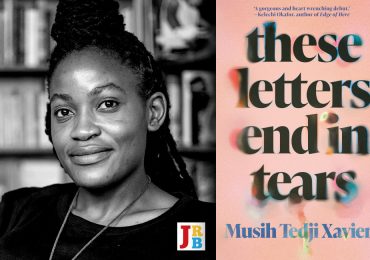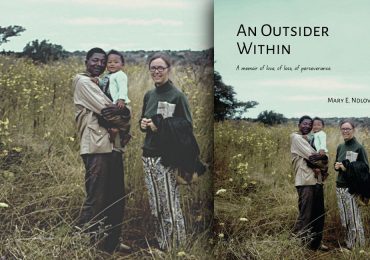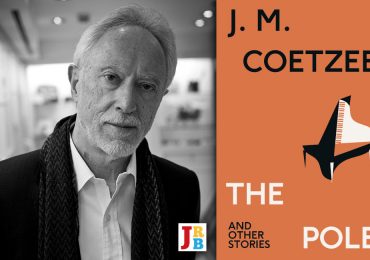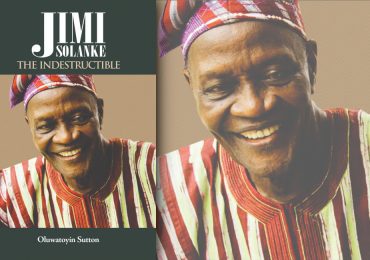Zikhona Valela reviews Winnie and Nelson: Portrait of a Marriage by Jonny Steinberg.

Winnie and Nelson: Portrait of a Marriage
Jonny Steinberg
HarperCollins Publishers, 2023
It comes as no surprise that a new book on the life of Nelson Mandela has been published. There is often disdain when yet another work on South Africa’s liberation icon appears, but these commentaries are important because they demonstrate the possibilities for nuanced archiving of figures of the liberation struggle. We live in the hope, however, that publishers will also take the lives of lesser-known individuals with as much seriousness as they do that of the first Black president of democratic South Africa.
Winnie and Nelson seems to take its cue from Elinor Sisulu’s biography Walter and Albertina Sisulu: In Our Lifetime, in which we see a work that juxtaposes two figures of the liberation movement not only as life partners but as colleagues in the work of dismantling apartheid. However Winnie and Nelson doesn’t really leave me with the impression that I have read a book about equals.
As the book is chronological, it begins with Nelson’s life. The first irksome detail is the use of ‘Thembu’ and ‘Xhosa’ interchangeably. As we are aware, and the book points out, Nelson was umThembu, who are a different people to the Xhosa, although they share a language and certain traditions, such as ulwaluko (circumcision)—although of course these will differ in finer details and protocols specific to each group. Professor Xolela Mangcu’s 2019 essay ‘Mandela: The Untold Heritage’ comes to mind here. Mangcu writes, ‘The odd thing about [the descriptions of Mandela’s Thembu heritage in various biographies] is that Nelson went to great lengths to explain to his “ghost writer” [for Long Walk to Freedom] why he was Thembu and not Xhosa.’ Winnie and Nelson, like many previous biographies of Nelson’s life, as Mangcu notes, would have benefited from a meditation on the Thembu royal protocols, as this heritage (although Mangcu’s focus is Nelson’s lineage) played a significant role in his marriage to Winnie Madikizela-Mandela, even after their divorce. So it was odd to arrive at the book’s end without having encountered an analysis of Winnie’s attempt to reclaim the Qunu home as influenced by the idea that their divorce was illegitimate in terms of tradition, even as Steinberg points to the ways their marriage was sustained or resurrected as Nelson’s health deteriorated.
The exploration of these nuances is one of the most interesting parts of this portrait. But I don’t envy Steinberg the task of excavating this aspect of Winnie and Nelson’s life. There is a limit to how far one can go into the details of their union, and its effect on the Mandela children can’t have been an easy thing to get out of the family. The absence of the close family’s perspective, accordingly, is glaring. The book relies on those who are quite distant from its two main figures, in addition to the Kobie Coetsee archive, which I will get into a little further on.
Nelson’s will excluded Winnie, and one wonders what she made of this. Might she have considered it a betrayal? Who could she have confided in, given that intimate details of his life tended to work their way into biographies about him? Steinberg’s book reveals, via a wildly indecorous anonymous source, that his relationship with Ruth Mompati, which occurred while he was married to Evelyn Mase, produced a son. I wonder about the ethics of revealing such information, which was disclosed in confidence. How do we tell intimate stories such as this one without violating boundaries in the ways Nelson’s enemies (and the enemies of the liberation movement in general) did? What of the dignity of the departed? How is the nakedness of school girls at Shawbury, the school Winnie attended as a teenager, relevant? Why does Winnie and Nelson preoccupy itself with their nakedness? What is Steinberg attempting to establish with this information? Even he seems unsure. ‘What are we to make of the sadistic scene Winnie conjured?’ he asks, then adds his somewhat cryptic interpretation: ‘The world is recast with the ferocity of the offense she has taken; her stories are, above all, a measure of the temperature in her inner world.’
As we follow Nelson into the 1930s, Winnie’s life story is brought to the fore, and Winnie and Nelson becomes a fascinating enquiry, in which Steinberg cuts through the facts and fictions that others have not scrutinised. It is quite a tricky thing to navigate. Many biographers and scholars of Winnie’s life have relied on Fatima Meer’s 1990 biography, Higher Than Hope. The author and activist dedicated chapters to both Evelyn Mase and Winnie’s lives. But in correspondence with Meer’s daughter Shamim Meer, I learned that the book was initially meant to be a biography of Winnie—which is why it provides us with so much information about her.
Steinberg challenges some of the narrative of Higher Than Hope. For instance, it documents how Winnie claimed to have read about the ANC in the popular magazine Zonk! African People’s Pictorial. As Steinberg rightly points out, it is bizarre that this detail has never been challenged, as it’s well-known that Zonk! kept out of politics. However, I would not be as quick as Steinberg to write Meer’s text off as distortion. Zonk!’s launch coincided with the premier of the film Jim Comes to Jo’burg/African Jim. This was the first film to target Black audiences specifically, and it launched the career of South Africa’s first Black leading lady, cover star and jazz songstress Dolly Rathebe. According to the 5 November 1949 issue of the Durban-based newspaper Um-Afrika, Dr AB Xuma, then president of the ANC, was present at the film’s premiere. Zonk!’s December issue covered this. Xuma is said to have opened his speech with the rallying call ‘Mayibuye iAfrika!’, a slogan the ANC later made famous during the Defiance Campaign. So when Winnie speaks of reading about the ANC in Zonk!, could she have been referring to this moment?
Then there are the details that aren’t scrutinised, such as Duma Nokwe’s attendance of Winnie and Nelson’s wedding in 1958. In an interview with Nokwe’s daughter, Dr Nomvuyo Nokwe, about the Mandelas, I came to learn that Nokwe, who was the first Black advocate admitted to the Transvaal Supreme Court, often recalled the event of his ‘kidnapping’ by the Madikizela kinsmen. But this was during the lobola negotiations. Nokwe was Nelson’s chief nozakuzaku and was never at the wedding, as Steinberg and many other biographers of Nelson and Winnie have written. This brings to the fore another issue for consideration. A source has been found wanting (in this case Meer’s biography), and yet it is also relied upon in other areas that do not seem to be factual, either.
I sense a similar conflict with the use of the Kobie Coetsee archives, housed at the University of the Free State, which contain transcripts of thousands of pages of recordings of Nelson from his time in prison. How reliable is this source, given the context of Nelson’s acute awareness that ‘the walls have ears’? (Nelson’s conversations were in fact bugged.) I put this question to Saki Macozoma, a former media representative of Nelson’s, who revealed that Nelson did indeed often jot notes on paper suggesting that conversations be moved outside so that he could speak freely.
One of the most difficult parts of Steinberg’s book is the very real sense of helplessness on Nelson’s part. It is quite stark, how much he tried to cling to his role as the patriarch of the family. The Long Walk to Freedom transcripts also reveal some of the responsibilities that Winnie shouldered as a proxy for her husband in his role as a senior member of the Madiba clan. It is curious that Winnie and Nelson does not explore this in greater detail. A portrait of an African marriage should consider the fact that such a union isn’t just about the husband and wife; it comes with duty and gives birth to other intimacies within the broader family—for instance, Winnie as umolokazana (daughter-in-law). (Moments such as this cause me to recall Toni Morrison’s comments on writing with and without the white gaze.) And of course, Nelson’s feelings of helplessness only increased as propaganda against Winnie made its way to Robben Island, Pollsmoor and Victor Verster.
But on the facts of Winnie’s conduct in the nineteen-seventies and eighties, what Steinberg’s book highlights, for me, is the extent to which women in the liberation movement were sidelined. Winnie has proudly spoken of her contribution to recruiting for Umkhonto weSizwe while in Brandfort, and the ways she stayed connected to the ANC in exile. Yet, Steinberg points out that the bulk of this was a farce, a form of leadership in exile orchestrated to keep Winnie away from some of the legitimate underground networks. I wonder how many other women who thought they were making a real contribution to the liberation movement were duped in this way. Steinberg also emphasises the extent to which Winnie’s network was infiltrated by informants, a fact that brings into focus just how vulnerable the liberation movement was against a well-oiled machine such as the apartheid regime. It recalls the Black Consciousness Movement (BCM) activist Onkgopotse Tiro’s communication with one of the people responsible for his assassination in 1974, Craig Williamson. Williamson (who was also involved in the assassination of Ruth First) and Tiro exchanged letters, with the former masquerading as a student interested in receiving a scholarship from one of the BCM’s funders, the International University Exchange Fund.
A startling distortion in Steinberg’s book pertains to the famous speech Winnie’s father, Columbus Madikizela, is said to have delivered on Winnie and Nelson’s wedding day, particularly his closing remark: ‘If your man is a wizard, you must become a witch!’ It’s possible that Madikizela may not have initially approved of his daughter’s choice of husband. Not only was Nelson twice her age and a divorcé with children that Winnie would have likely had to take some responsibility for, he was among the leading outlaws targeted by the apartheid regime. Even their wedding was impacted by Nelson’s banning order conditions. But the notion Steinberg puts forward that Madikizela in some way cursed his daughter—‘You have chosen him against my wishes, he was saying to Winnie, and so you will become a witch’—is a complete untruth. For an isiXhosa-speaking person, it is typical to use this saying when imparting words of wisdom to a new bride, what isiXhosa-speaking people refer to as ukuyalwa. Sometimes the phrase is used in times when the young bride finds herself in an environment that is starkly different to what she is used to, that may go against how she has been raised. Some families even go as far as to tell women: ‘If your in-laws are flying on brooms, grab one for yourself and get to flying.’ Madikizela would have understood that Winnie, young as she was, was entering a foreign environment that could see her tested to the point of giving up on her marriage. After all, we have come to know that part of the reason Nelson and Evelyn Mase’s marriage failed was his commitment to the Defiance Campaign. However, as Winnie and Nelson’s previous biographers point out, by saying this, Madikizela was simply indicating that he expected Winnie to ‘do as the Romans do’. Rather than being a curse, the words were to encourage Winnie to be as committed to the liberation movement as his new son-in-law, whom he described as being already married to the struggle.
At the end of the Winnie and Nelson, Steinberg reflects on Winnie’s re-emergence as a hero of the liberation movement, alongside other forgotten figures such as Robert Sobukwe. He laments the fact that, by contrast, Nelson came to be seen by some as a sell-out, and talks about the ways in which the Mandela administration attempted to redress the injustices of apartheid. However, Steinberg’s notion that the idea of Nelson as a sell-out emerged among ‘young, educated black South Africans’ in the early 2010s—by implication the Rhodes Must Fall generation—is incorrect. In my work on Mapetla Mohapi, a leading member of the BCM, and the first to die in detention in 1976, Nelson’s betrayal came up again and again in interviews—with, for example, members of the BCM’s South African Students Organisation (SASO), Black People’s Convention (BCP), and Black Community Programmes (BCP) organisations. The sense of betrayal has a longer history than many imagine.
There are people who lived through apartheid who feel sold out by the ANC, and we are yet to unpack this. Instead, those who voice disappointment in our democratic era—in which apartheid’s legacy lives on more strongly than the many activists who gave their lives in the pursuit of freedom—are dismissed as young people who do not know their history. The sooner we are able to have honest discussions about the many unfulfilled ideals of the liberation movement, the sooner we will get back on course towards redress. Perhaps the recent fire in Johannesburg that ended with the deaths of seventy-seven people in a building that was once a pass office will jolt us to action.
- Zikhona Valela is a historian and author of Now You Know How Mapetla Died: The Story of a Black Consciousness Martyr.





